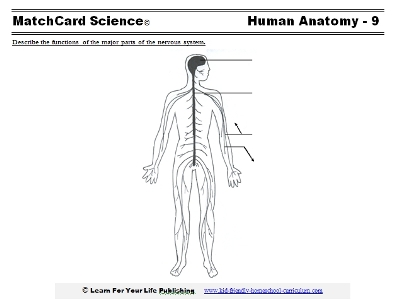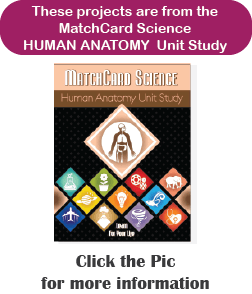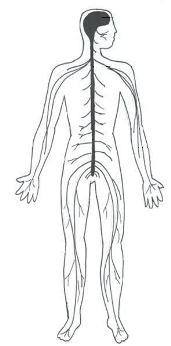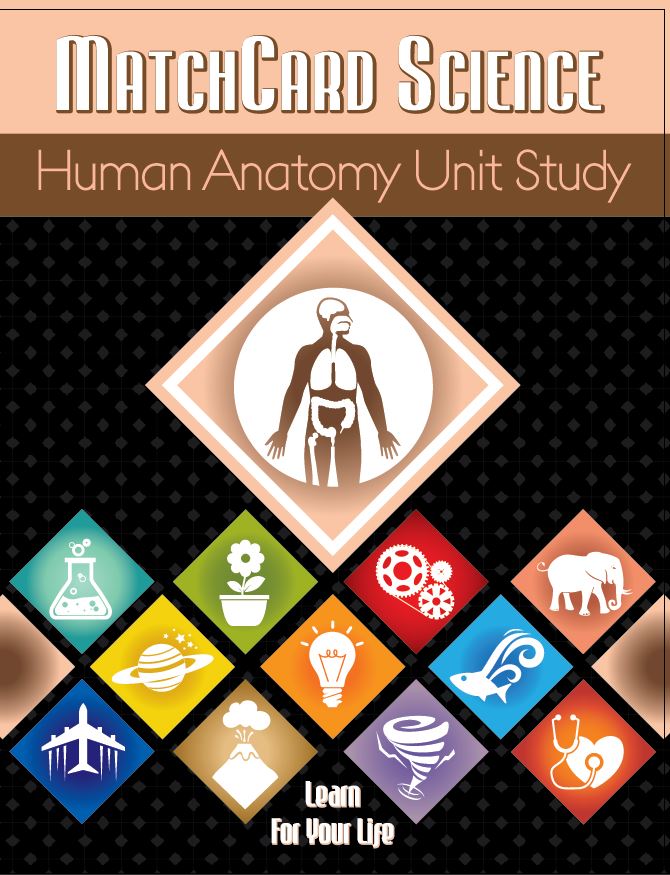Nervous System for Kids
Students learn about the function of the brain, spinal cord, and nerves on our nervous system worksheet.
Free Download Below


Nervous System for Kids MatchCard
Objective: Describe the functions of the major parts of the nervous system:- brain
- spinal cord
- motor nerves
- sensory nerves.
The MatchCard Information Pieces identify the name and describe the function of the brain, spinal cord, motor nerves and sensory nerves.
Ideas for projects are listed on the instructor's page and below.
Print the Nervous System Diagram and Worksheet
This is MatchCard #9 of the Human Anatomy Unit Study. Match the names and descriptions to the nervous system diagram on Page 1.Learn the Parts of the Human Nervous System
 The Human Nervous System MatchCard teaches students the function of the major parts of the nervous system.
The Human Nervous System MatchCard teaches students the function of the major parts of the nervous system.
Brain
The brain is the control center of the human body. It takes in all the messages coming into it and sends out orders to all other parts of the body.To put it in scientific terms, the brain:
- integrates incoming signals
- regulates body functions
How smart do you think you would be without your brain?
Spinal Cord
The spinal cord is a bundle of long nerves. It connects the brain to all the nerves in the skin and the organs of the body.The spinal cord carries messages to and from the brain.
Have you ever noticed the vertebrae on a skeleton? You can see much of the backbone if a person bends over without their shirt on. The backbone has a serious job to do. It protects the very important spinal cord.
Sensory Nerves
You have heard of your five senses: smell, taste, sight, hearing, touch.It is the sensory nerves that take the messages received from your environment and relay the information to your brain. Without those sensory nerves, you would not have any of the five senses.
Motor Nerves
The motor nerves carry a message from your brain telling you to move your bones and muscles. You would never get anywhere without them.Projects and Activities for the Nervous System
Discussion Question
Why do people jump when they see a small black thing moving up the wall out of the corner of their eye? The same person would not jump if they saw curtains blowing in the wind.Have you ever done a "double-take?" Describe it. What part did your nervous system play in that situation?
Blink Reflex
Teacher’s Note: Be prepared to snap your fingers or clap your hands in front of the student’s face unexpectedly. The idea is to initiate the blink reflex, not to scare the student.Discussion: Why did you blink? The blink reflex gets activitated very easily if something unexpectedly comes near our face. Why? Your eyes are important and they are fairly easily injured. Your body needs to protect them “in the blink of an eye.” You don’t have time to sit and think if something may be dangerous to your eyes; you just blink.
Check Those Reflexes
You may need to sit on a table or counter to make this next reflex work.With your leg dangling, try to initiate the knee reflex by tapping briskly on the area right below the knee.
Describe what the sensory nerves and motor nerves are doing.
Sensory Stimulation
Place one of these objects in the hand of a blind-folded partner:- key
- coin
- paper clip
- piece of cereal.
Differentiation
Differentiation refers to the ability of a person's nervous system to detect the touch of an object on their skin. In this case, it detects the ability to determine if one or two objects are touching them. If the two items are close together on the skin, there may only be one nerve stimulated. It then feels like only one object is touching the skin instead of two.Take two sharp pencil points and touch them one inch apart on the palm of a blindfolded partner. How many points do they feel? Bring the two points closer together until they feel only one point.
With all of the above activities, trace what is happening in sensory nerves, the spinal cord, brain and motor nerves.
Science Experiment with differentiation.
Integration
Here is a fun way of exploring more about the nervous system for kids. Play an action game and then have them reflect on how their sensory and motor nerves worked to help them play the game. Here are a few choices of games that would work well:- Twister
- Pick Up Sticks
- Jump Rope
- Blind Mans Bluff
MatchCard Science
How To Use MatchCards

Download the FREE MatchCard Science Instructor's Guide and see how MatchCards can make building their science knowledge base fun.
Human Anatomy Unit Study

Download the entire Human Anatomy Unit Study
12 Science Unit Studies

Chemistry is only one of twelve complete unit studies for kids in 3rd to 8th grade.
Comprehensive objectives, hands-on projects, suggested science fair experiments, and the fun game-like MatchCards keep them interested in learning science. See all twelve MatchCard Science Unit Studies.
About Our Site
Hands-On Learning














